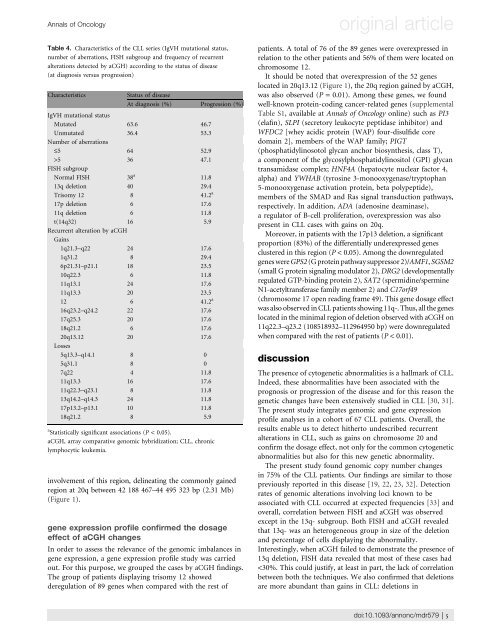Alberto Risueño Pérez - Gredos - Universidad de Salamanca
Alberto Risueño Pérez - Gredos - Universidad de Salamanca
Alberto Risueño Pérez - Gredos - Universidad de Salamanca
You also want an ePaper? Increase the reach of your titles
YUMPU automatically turns print PDFs into web optimized ePapers that Google loves.
Annals of Oncology original article<br />
Table 4. Characteristics of the CLL series (IgVH mutational status,<br />
number of aberrations, FISH subgroup and frequency of recurrent<br />
alterations <strong>de</strong>tected by aCGH) according to the status of disease<br />
(at diagnosis versus progression)<br />
Characteristics Status of disease<br />
At diagnosis (%) Progression (%)<br />
IgVH mutational status<br />
Mutated 63.6 46.7<br />
Unmutated<br />
Number of aberrations<br />
36.4 53.3<br />
£5 64 52.9<br />
>5<br />
FISH subgroup<br />
36 47.1<br />
Normal FISH 38 a<br />
11.8<br />
13q <strong>de</strong>letion 40 29.4<br />
Trisomy 12 8 41.2 a<br />
17p <strong>de</strong>letion 6 17.6<br />
11q <strong>de</strong>letion 6 11.8<br />
t(14q32) 16 5.9<br />
Recurrent alteration by aCGH<br />
Gains<br />
1q21.3–q22 24 17.6<br />
1q31.2 8 29.4<br />
6p21.31–p21.1 18 23.5<br />
10q22.3 6 11.8<br />
11q13.1 24 17.6<br />
11q13.3 20 23.5<br />
12 6 41.2 a<br />
16q23.2–q24.2 22 17.6<br />
17q25.3 20 17.6<br />
18q21.2 6 17.6<br />
20q13.12<br />
Losses<br />
20 17.6<br />
5q13.3–q14.1 8 0<br />
5q31.1 8 0<br />
7q22 4 11.8<br />
11q13.3 16 17.6<br />
11q22.3–q23.1 8 11.8<br />
13q14.2–q14.3 24 11.8<br />
17p13.2–p13.1 10 11.8<br />
18q21.2 8 5.9<br />
a Statistically significant associations (P < 0.05).<br />
aCGH, array comparative genomic hybridization; CLL, chronic<br />
lymphocytic leukemia.<br />
involvement of this region, <strong>de</strong>lineating the commonly gained<br />
region at 20q between 42 188 467–44 495 323 bp (2.31 Mb)<br />
(Figure 1).<br />
gene expression profile confirmed the dosage<br />
effect of aCGH changes<br />
In or<strong>de</strong>r to assess the relevance of the genomic imbalances in<br />
gene expression, a gene expression profile study was carried<br />
out. For this purpose, we grouped the cases by aCGH findings.<br />
The group of patients displaying trisomy 12 showed<br />
<strong>de</strong>regulation of 89 genes when compared with the rest of<br />
patients. A total of 76 of the 89 genes were overexpressed in<br />
relation to the other patients and 56% of them were located on<br />
chromosome 12.<br />
It should be noted that overexpression of the 52 genes<br />
located in 20q13.12 (Figure 1), the 20q region gained by aCGH,<br />
was also observed (P = 0.01). Among these genes, we found<br />
well-known protein-coding cancer-related genes (supplemental<br />
Table S1, available at Annals of Oncology online) such as PI3<br />
(elafin), SLPI (secretory leukocyte peptidase inhibitor) and<br />
WFDC2 [whey acidic protein (WAP) four-disulfi<strong>de</strong> core<br />
domain 2], members of the WAP family; PIGT<br />
(phosphatidylinosotol glycan anchor biosynthesis, class T),<br />
a component of the glycosylphosphatidylinositol (GPI) glycan<br />
transamidase complex; HNF4A (hepatocyte nuclear factor 4,<br />
alpha) and YWHAB (tyrosine 3-monooxygenase/tryptophan<br />
5-monooxygenase activation protein, beta polypepti<strong>de</strong>),<br />
members of the SMAD and Ras signal transduction pathways,<br />
respectively. In addition, ADA (a<strong>de</strong>nosine <strong>de</strong>aminase),<br />
a regulator of B-cell proliferation, overexpression was also<br />
present in CLL cases with gains on 20q.<br />
Moreover, in patients with the 17p13 <strong>de</strong>letion, a significant<br />
proportion (83%) of the differentially un<strong>de</strong>rexpressed genes<br />
clustered in this region (P < 0.05). Among the downregulated<br />
genes were GPS2 (G protein pathway suppressor 2)/AMF1, SGSM2<br />
(small G protein signaling modulator 2), DRG2 (<strong>de</strong>velopmentally<br />
regulated GTP-binding protein 2), SAT2 (spermidine/spermine<br />
N1-acetyltransferase family member 2) and C17orf49<br />
(chromosome 17 open reading frame 49). This gene dosage effect<br />
was also observed in CLL patients showing 11q-. Thus, all the genes<br />
located in the minimal region of <strong>de</strong>letion observed with aCGH on<br />
11q22.3–q23.2 (108518932–112964950 bp) were downregulated<br />
when compared with the rest of patients (P < 0.01).<br />
discussion<br />
The presence of cytogenetic abnormalities is a hallmark of CLL.<br />
In<strong>de</strong>ed, these abnormalities have been associated with the<br />
prognosis or progression of the disease and for this reason the<br />
genetic changes have been extensively studied in CLL [30, 31].<br />
The present study integrates genomic and gene expression<br />
profile analyses in a cohort of 67 CLL patients. Overall, the<br />
results enable us to <strong>de</strong>tect hitherto un<strong>de</strong>scribed recurrent<br />
alterations in CLL, such as gains on chromosome 20 and<br />
confirm the dosage effect, not only for the common cytogenetic<br />
abnormalities but also for this new genetic abnormality.<br />
The present study found genomic copy number changes<br />
in 75% of the CLL patients. Our findings are similar to those<br />
previously reported in this disease [19, 22, 23, 32]. Detection<br />
rates of genomic alterations involving loci known to be<br />
associated with CLL occurred at expected frequencies [33] and<br />
overall, correlation between FISH and aCGH was observed<br />
except in the 13q- subgroup. Both FISH and aCGH revealed<br />
that 13q- was an heterogeneous group in size of the <strong>de</strong>letion<br />
and percentage of cells displaying the abnormality.<br />
Interestingly, when aCGH failed to <strong>de</strong>monstrate the presence of<br />
13q <strong>de</strong>letion, FISH data revealed that most of these cases had<br />
















